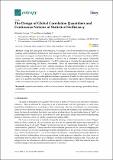The Design of Global Correlation Quantifiers and Continuous Notions of Statistical Sufficiency
Author(s)
Carrara, Nicholas; Vanslette, Kevin
Downloadentropy-22-00357-v2.pdf (479.0Kb)
Publisher with Creative Commons License
Publisher with Creative Commons License
Creative Commons Attribution
Terms of use
Metadata
Show full item recordAbstract
Using first principles from inference, we design a set of functionals for the purposes of ranking joint probability distributions with respect to their correlations. Starting with a general functional, we impose its desired behavior through the Principle of Constant Correlations (PCC), which constrains the correlation functional to behave in a consistent way under statistically independent inferential transformations. The PCC guides us in choosing the appropriate design criteria for constructing the desired functionals. Since the derivations depend on a choice of partitioning the variable space into n disjoint subspaces, the general functional we design is the n-partite information (NPI), of which the total correlation and mutual information are special cases. Thus, these functionals are found to be uniquely capable of determining whether a certain class of inferential transformations, ρ→∗ρ′ , preserve, destroy or create correlations. This provides conceptual clarity by ruling out other possible global correlation quantifiers. Finally, the derivation and results allow us to quantify non-binary notions of statistical sufficiency. Our results express what percentage of the correlations are preserved under a given inferential transformation or variable mapping. Keyword: n-partite information; total correlation; mutual information; entropy; probability theory; correlation
Date issued
2020-03Department
Massachusetts Institute of Technology. Department of Mechanical EngineeringJournal
Entropy
Publisher
Multidisciplinary Digital Publishing Institute
Citation
Carrara, Nicholas, and Kevin Vanslette. "The Design of Global Correlation Quantifiers and Continuous Notions of Statistical Sufficiency." Entropy, 22 (March 2020): 357. © 2020 The Author(s).
Version: Final published version
ISSN
1099-4300